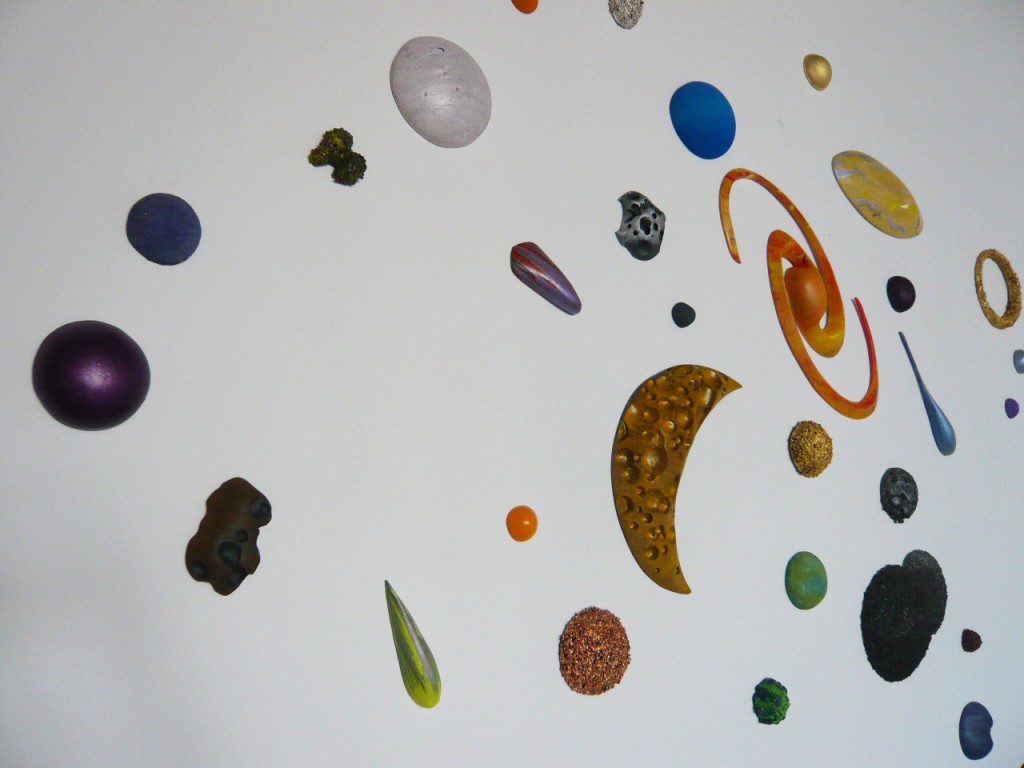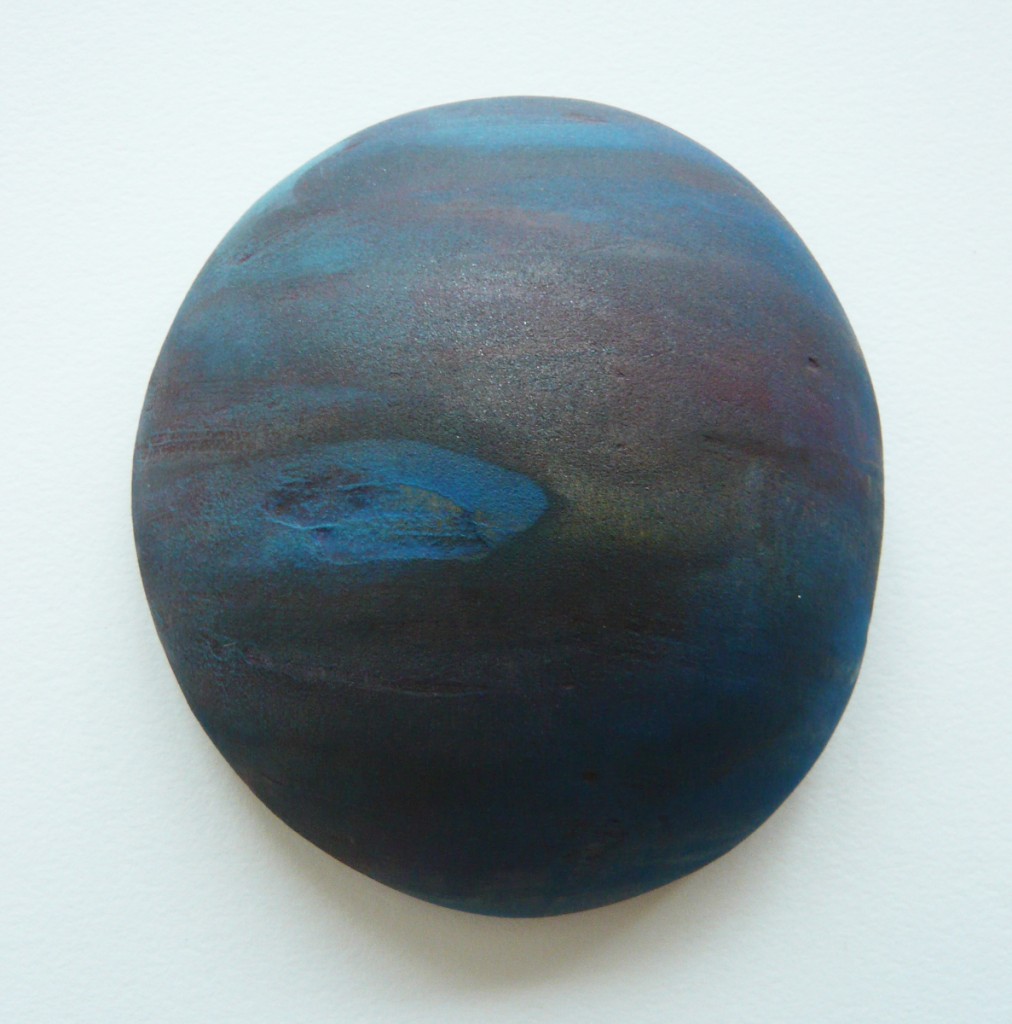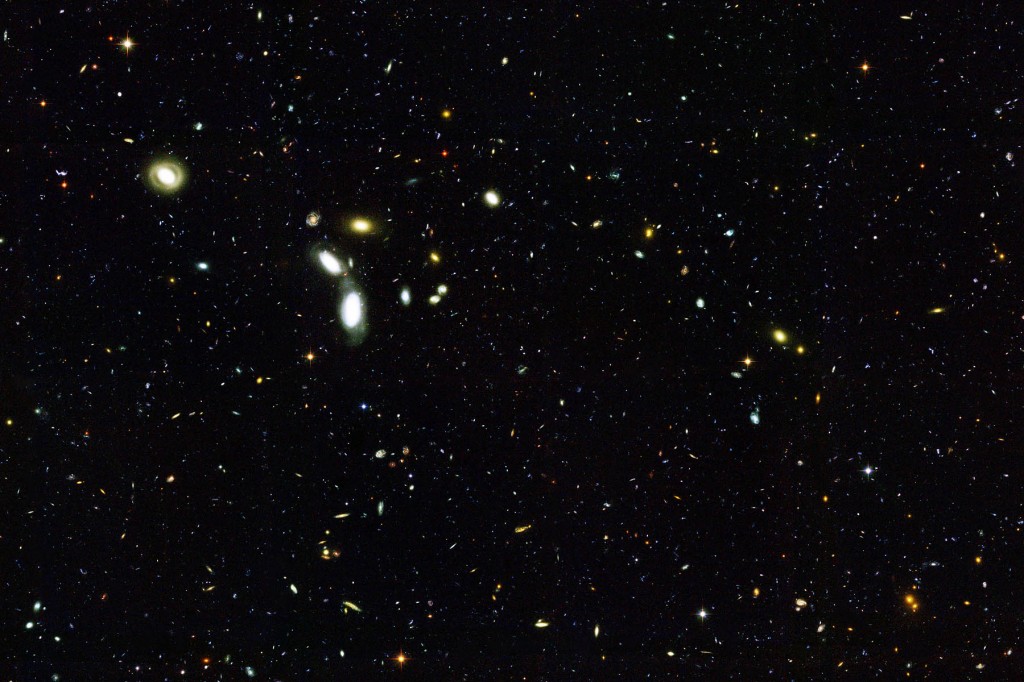Marcela Silva’s Galactic Objects
Marcela Silva was in Chile when we started corresponding this October. “Trees are blossoming here,” she signed off one night. Water was kicked up by a landing satellite on the moon, new images of Saturn traveled back to us from the spacecraft Cassini, and Marcela returned to New York where fall drew the leaves earthward. She dove into a rushed editing project for her job, and carved out time in her Williamsburg, Brooklyn studio to hang her galactic objects (“celestial peculiarities”) into panoramas like the one above. As our correspondence wound down—its own space and time settling into the paragraphs below—I asked her for a biographical note about herself. She emailed back. “If I had my druthers my bio would be: earthling.”—Elaine Bleakney
AL
What drew you into this project?
MS
When the Kepler observatory was launched by NASA earlier in the year, I kept dreaming about the oddities that it may come across in its quest for “earth-like” planets. That’s essentially what I’ve been compiling for the past few months. The piece is an accumulation of galactic objects. I sculpt an object (meteor, comet, black hole, galaxy, planet, etc.) which I then paint. The individual components are diverse in size and the overall dimension has varied—I suppose it may never be “finished.”
I call them “celestial peculiarities” because that’s what the “amateur” astronomers of yester-year used to call any celestial object that they could not identify. There were a lot of peculiarities. ”Amateur” because most of the significant astronomers had other occupations (day-jobs) and studied space at night, obviously. I think about the intellectual and creative acumen of these people. They lived balanced lives. In our “modern” world we’re all very specific. Maybe this economy will provide various experiences rather than a single path. Tangent…
AL
How does one of your “peculiarities” first take shape?
MS
Some emerge from the process while others are more deliberate.
Those that I belabor may result from my trying to visualize a specific type of celestial object: what would a black hole look like, either from afar or below the event horizon? What about dark matter? Couldn’t there be a silver meteor instead of iron? What colors do we associate with certain elements? Could a comet be pink? Would the big bang, if viewed from afar, looked like a sphere? Lumpy or smooth? Would it have emitted light at that initial moment of compression? Usually I’ll have a very specific shape that I’ll cut and then build upon. I’ll even note on a slip of paper what pigments or paint process to consider. (Ultimately though—each piece is subject to the whims of the day, especially if the piece has evolved away from the intended outcome during a previous stage.)
With Kepler, I started tinkering with our limited perception of space objects. And I started doodling. My friend, Jim Hanson, saw the initial output and asked me to make a few for a project that he had for Architectural Digest. I made a dozen for him. After I delivered them I had this feeling of absence so I decided to make more to repopulate the area in my studio.
They’ve also provided an outlet to color. I’ve always considered myself a colorist but my output over the past decade has been limited by the subject matter. (Color was “direct” and had associations.) The peculiarities are all about invention, so I’m mixing strident and ridiculous color combinations. There’s a greediness. I have the satisfaction of seeing that I’m still pretty good at it—after all these years…
AL
I like that your “limited perception” of these objects has opened up a whole field of discovery for you. In his observations about sea shells, Paul Valéry wrote about how shells are “privileged objects,” where he finds a kind of “intention and action that seem to have fashioned them as man might have done, but at the same time we find evidence of methods forbidden and inaccessible to us.” Does your limited perception of objects in space irk you at all or just fuel you further within the momentum of the project?
MS
As there are very few true visual definitions of what I’m attempting to paint, I’m postulating unknowns, while simultaneously satisfying my qualifications for painting. In the story or continuity of painting—I’m making things that have not been seen before. My paintings are as foreign as the space objects (or panoramas) they depict. In addition, I’m painting in a manner or with a technique that I’ve invented.
Mrs. Shapiro was my art teacher in elementary school. I resisted “learning” skills or tools. She perceived this and told me that no matter what I made it would be mine. It’s always going to be the result of “everything you bring to it.”
While in Chile recently, I saw a show of art created by the citizens of a tiny, rural hamlet in Peru. The work was uniformly stunning. Each artist had evolved their skill set to the highest degree. One farmer drew his crops and cattle. He flattened them upon the page within a flattened corral. Everything appeared to have been pushed over—not necessarily in profile, but to avoid overlap, and to clearly identify details and outline. There was no gray. Only black and white. The technique or skill was as important as the content in determining his art.
This era of painting is about differences. Individuals carve niches. I’m a firm believer that the materials and craft inform and create the work.
AL
Do you feel a consciousness within your own work, when you are able to step back to see that your skills or technique have successfully matched or harmonized with the content?
MS
I don’t know. Initially it’s bewilderment that what I’ve made are mine (particularly if I’ve been away from the studio for more than twenty-four hours). It’s a bit like not recognizing yourself after a haircut. Seamus Heaney gave a lecture in Seattle in the 90s, and I will butcher this, but he said something like: I write what I write— not what I want to write or it’s never as good as the marvelous poems that are in my head. Insert “make” for “write.” I don’t know if it’s humility or disassociation from disappointment…? Does my Peruvian counterpart dream of Constable? Does he wish he could depict volume in clouds?
Sometimes my “solution” and skills coalesce, but sometimes it’s a slog and every last mark is a titanic struggle—often ending with a storm of Saturn. These peculiarities work. If I may—all of my celestial panoramas get there. They’re joyful/ecstatic—and they’re mine.
AL
To go back to the beginning of this project for you, I’m interested in how it arrived as a tangent—almost like a comet itself.
MS
This may be redundant, but I kept wondering what the Kepler would see. It made me troll through recent images from JPL at NASA, particularly the stunning photographs taken by Cassini of Saturn. (Some of those images were used to create the space-scapes in the recent Star Trek movie. Holy moly!) And then, there was an extremely complicated shuttle mission in May that successfully revitalized Hubble and made its lens even more powerful. (NASA recently released the first images from the upgrade.) I’m no expert, but clearly we are living during a profoundly important era in astronomy and astrophysics.
AL
As each of your objects becomes itself, do you get closer to the “amateur” astronomers you admire?
MS
That era seems so remote. There was a quiet in the world. Imagine the night sky unpolluted with streetlights/electricity? I’ve been reading a lovely book by Richard Holmes: The Age of Wonder; How the Romantic Generation Discovered the Beauty and Terror of Science. It has several chapters on various Romantic era personages and the realms of science that their discoveries impacted. Herschel found Uranus, but only after “sweeping” the night sky for years and charting it—staying up all night, every night, regardless of weather and looking—teaching his eyes to see. He was the first one to show us that the sky was not a dome suspended over the earth, but a profoundly huge expanse, hence the terror.
In one respect these peculiarities have brought me closer: science and art are very similar.
AL
I read this take on Holmes’s book recently. To think of scientists discovering discovery in this way, as “amateurs,” greatly appeals. I wonder if we’re not hungry for the connection now because there’s so much media focus on technology and Silicon Valley as the discovery realm—a constant narration to this inter/marketspace. Discoverers have to become entrepreneurs for their discoveries so quickly there.
Is being an “amateur”—tending one’s activity within the love of discovery—and holding a day-job essential to your art-making? How do you find time to create this balance?
MS
First, I should clarify the use of “amateur astronomers” that I mentioned at the beginning of our correspondence. Mr. Herschel (and his sister for that matter), who are well-represented in The Age of Wonder, do not qualify as “amateur.” They were the real deal. Their music informed their ability to “read the sky” but in no way made their astronomical interests secondary. It was understood that “philosophical” research was not an acceptable source of income for eligibility. I think Herschel was forty by the time he had perfected his seven-foot telescope and began manufacturing it.
(Our modern love of “Renaissance” men/women and this perverse need to apply the “genius” tag—what’s that all about? Is it the result of our cultural/contemporary singularity? What’s wrong with a liberal arts education? Singularity makes for boring cocktail parties…)
The day-job gets me down. No matter how intellectually fulfilling—there is no balance. As I mentioned before, the strategic use of time constrains output. Walking into the studio after a ten hour day in an office (or wherever) does not great art make. I fake myself out by having a cappuccino at Gimme after getting off the train in the hopes it will “restart” the day.
AL
Let’s talk coffee. How does that loving cup enter into your process?
MS
The cappuccino is my afternoon land bridge. I shake off the subway and defog/reorient the head back to its original priority. “Restart.” Usually I engage in mindless banter with the baristas and in fifteen minutes I’m on my way down the hill to 87 Richardson. It does help squelch my perennial opponent (time) at least until its effects start to wear off. I’m from the Philip Guston/Fred Rogers school. I walk through the door, change my clothes, and get to work. Funny thing—I never had a cappuccino before moving to NYC. Even when I lived in Seattle I rarely had caffeine. Repeat visits to Rome did me in.
AL
Do you have ideas about why this project moved from the side to centerstage?
MS
I “let go” when I’m working on something that’s “not important.” I don’t worry about the investment of time or outcome—because generally I give it very little energy and have it around as something to think about and revisit. Time is my enemy. Having the day-job forces me to be very strategic with my studio time. There’s probably too much discipline. The initial scale of the peculiarities was smaller than my “regular” work and lacked preciousness. The freedom allows me to experiment heavily. I’m not anxious if I screw one up as there’s always another and they should evolve.
Economics is also a motivator and a practical reality in two respects. There’s the time commitment I mentioned but also the cost of materials. A big painting is an investment. These peculiarities are fiscally microscopic. I’m recycling remnants from paintings past so my expenses are low and that’s necessary right now since people aren’t buying paintings from unknown artists. My second economic motivator is affordable art. The peculiarities are not intended for one but should be disseminated like a big-bang dispersion.
Marcela Silva emigrated with her immediate family from Chile. She grew up in many environments, urban and rural, and from a very early age was exposed to art and science (her parents are both scientists). She has taught history, art history, studio arts, and juggled a myriad of day-jobs from baker to editor. More of her work can be found on her website, marcelasilva.com







